中考英语动词考点梳理与精练
图片预览
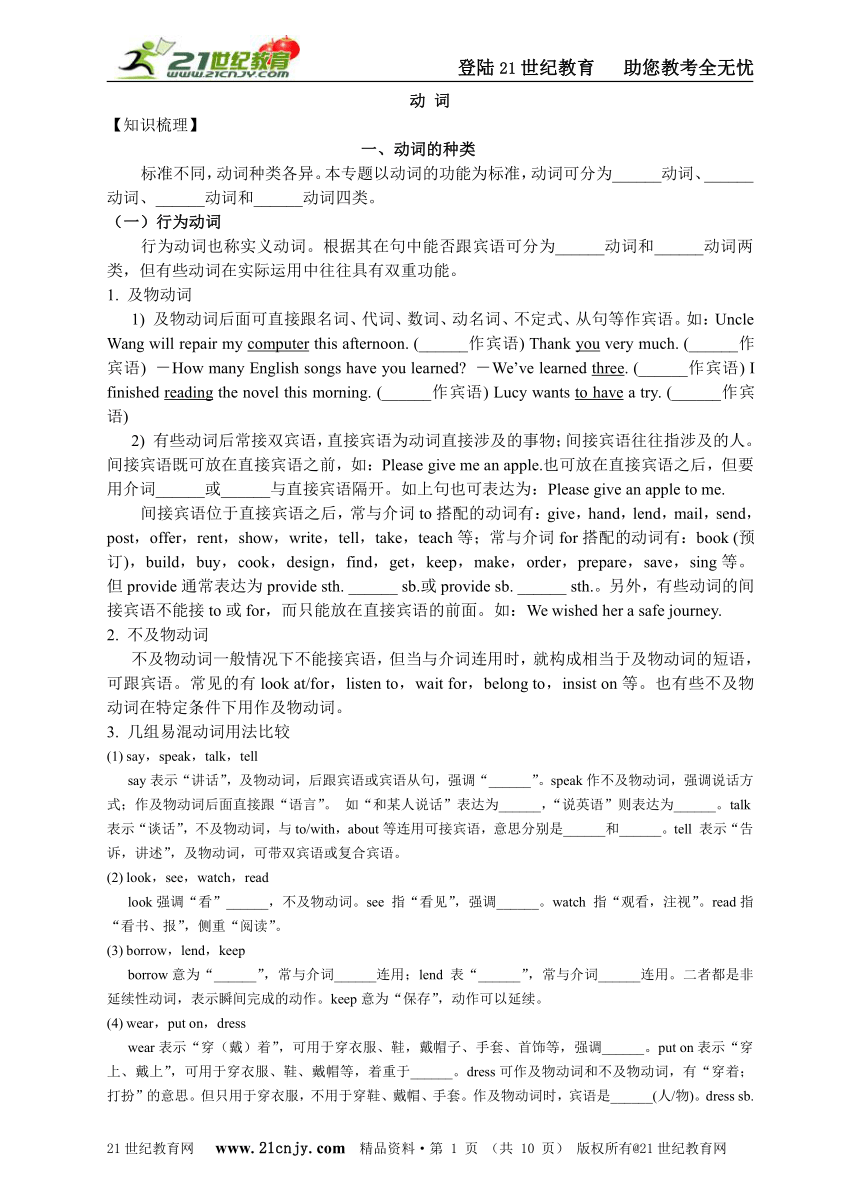
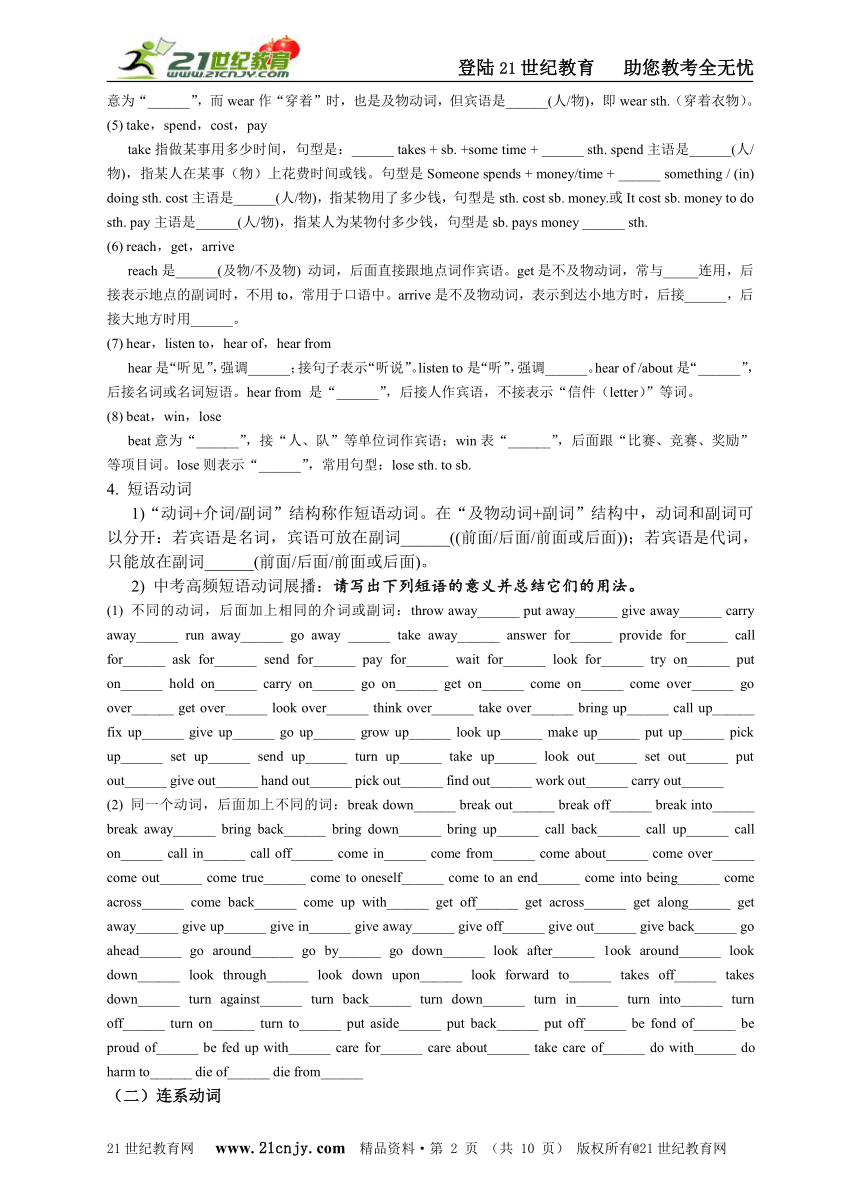
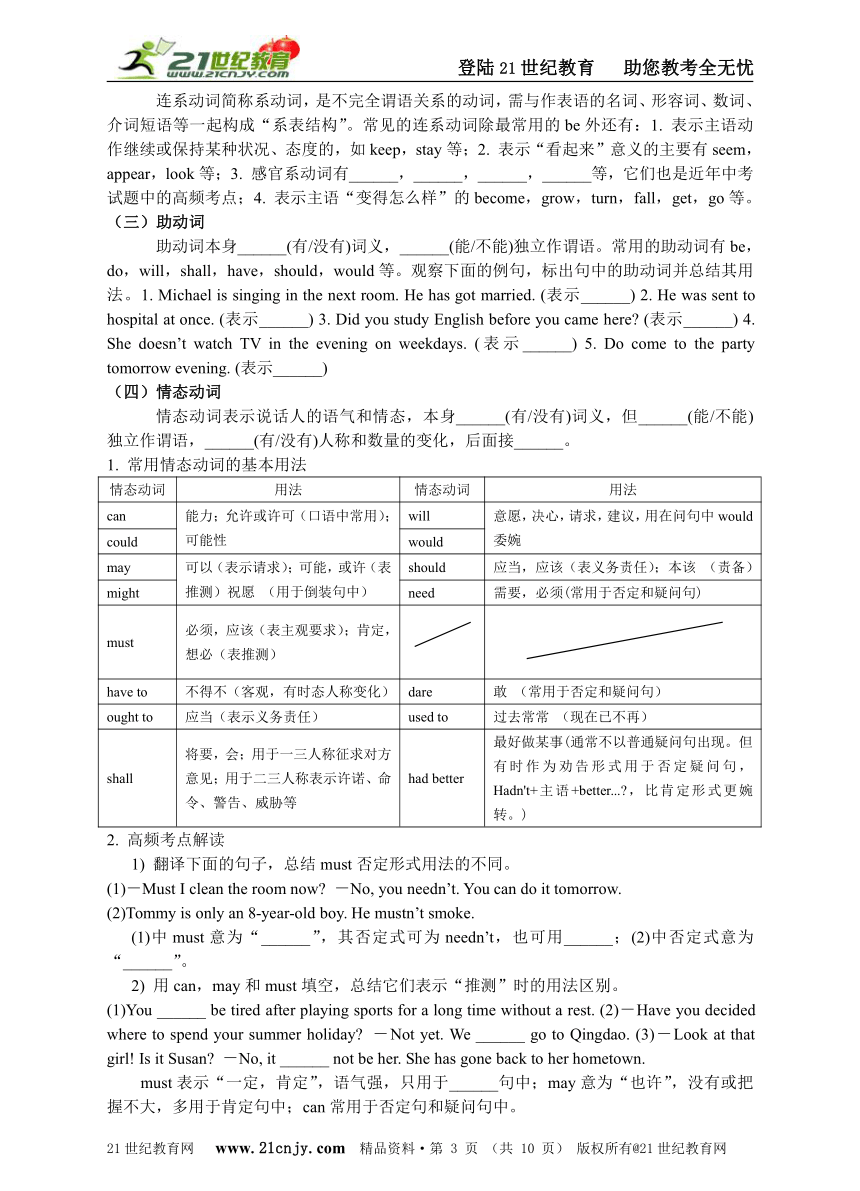
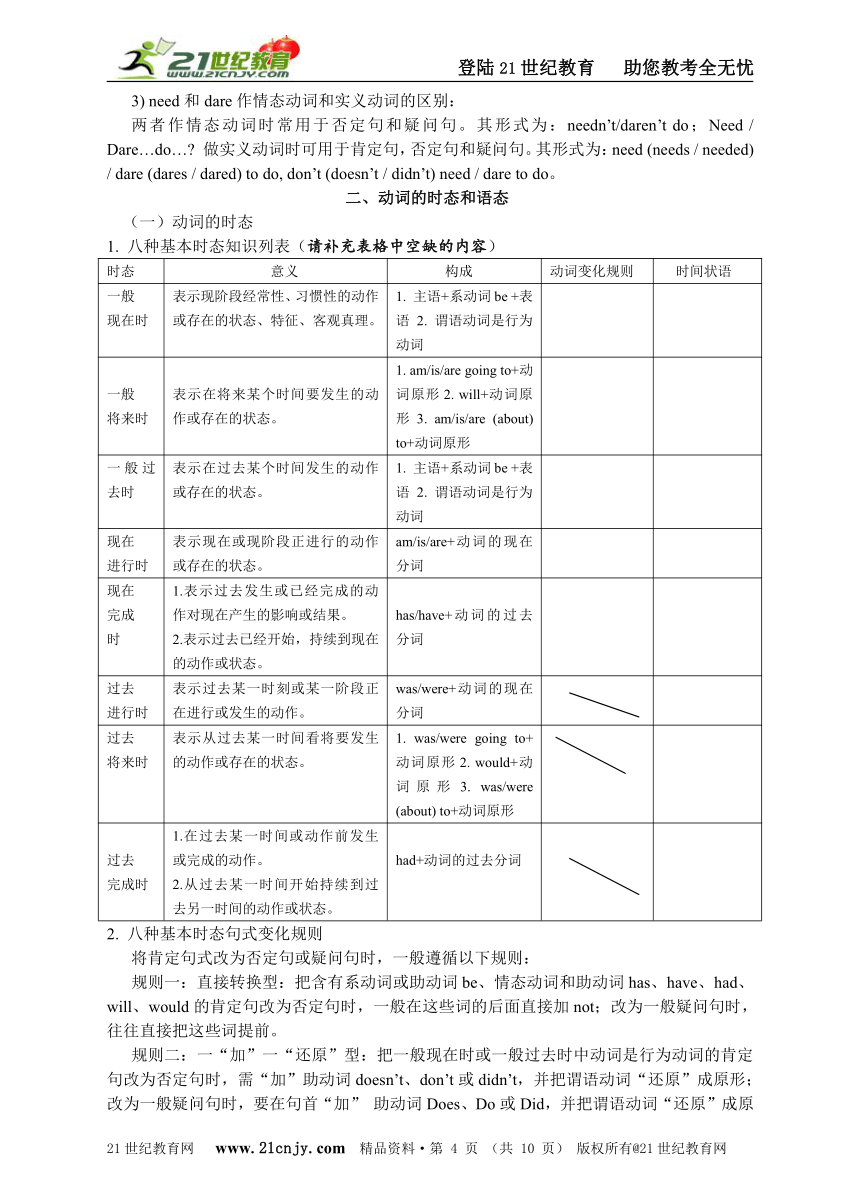
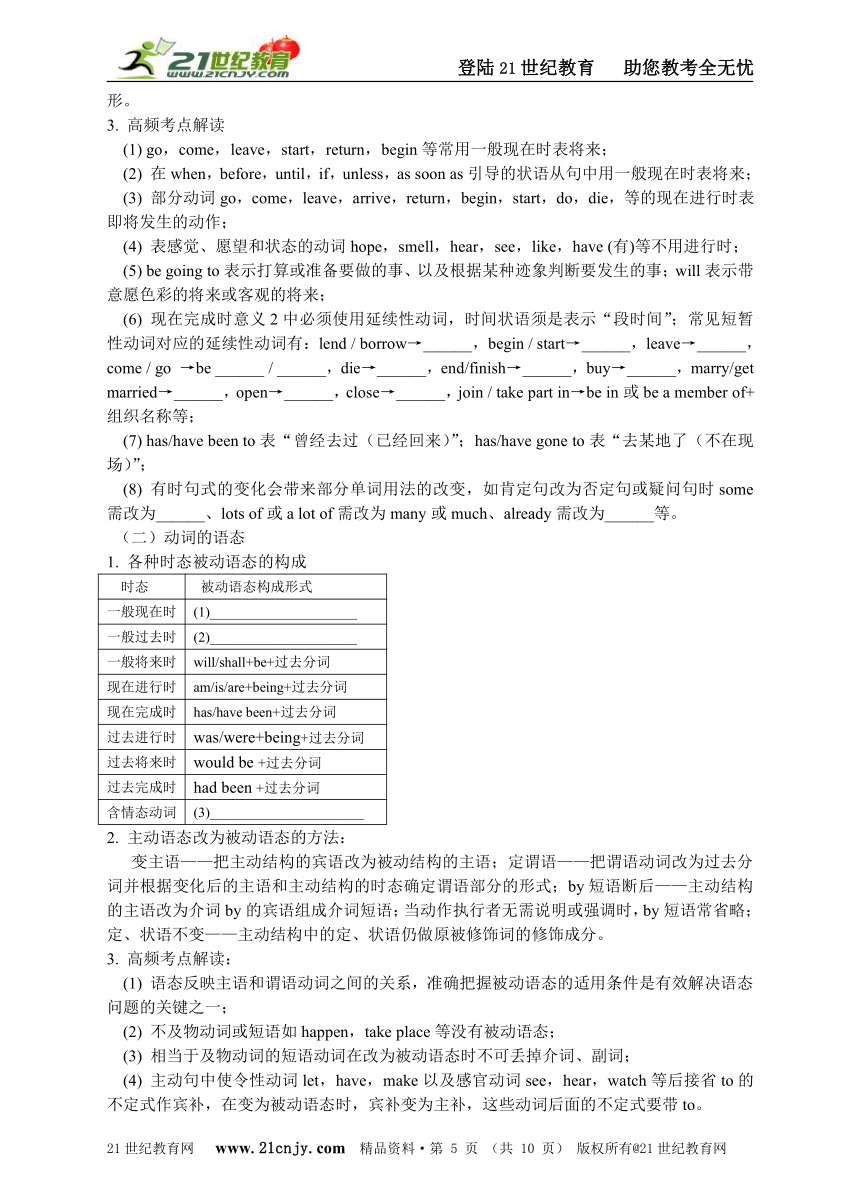
文档简介
登陆21世纪教育 助您教考全无忧
动 词
【知识梳理】
一、动词的种类
标准不同,动词种类各异。本专题以动词的功能为标准,动词可分为______动词、______动词、______动词和______动词四类。
(一)行为动词
行为动词也称实义动词。根据其在句中能否跟宾语可分为______动词和______动词两类,但有些动词在实际运用中往往具有双重功能。
1. 及物动词
1) 及物动词后面可直接跟名词、代词、数词、动名词、不定式、从句等作宾语。如:Uncle Wang will repair my computer this afternoon. (______作宾语) Thank you very much. (______作宾语) -How many English songs have you learned -We’ve learned three. (______作宾语) I finished reading the novel this morning. (______作宾语) Lucy wants to have a try. (______作宾语)
2) 有些动词后常接双宾语,直接宾语为动词直接涉及的事物;间接宾语往往指涉及的人。间接宾语既可放在直接宾语之前,如:Please give me an apple.也可放在直接宾语之后,但要用介词______或______与直接宾语隔开。如上句也可表达为:Please give an apple to me.
间接宾语位于直接宾语之后,常与介词to搭配的动词有:give,hand,lend,mail,send,post,offer,rent,show,write,tell,take,teach等;常与介词for搭配的动词有:book (预订),build,buy,cook,design,find,get,keep,make,order,prepare,save,sing等。但provide通常表达为provide sth. ______ sb.或provide sb. ______ sth.。另外,有些动词的间接宾语不能接to或for,而只能放在直接宾语的前面。如:We wished her a safe journey.
2. 不及物动词
不及物动词一般情况下不能接宾语,但当与介词连用时,就构成相当于及物动词的短语,可跟宾语。常见的有look at/for,listen to,wait for,belong to,insist on等。也有些不及物动词在特定条件下用作及物动词。
3. 几组易混动词用法比较
(1) say,speak,talk,tell
say表示“讲话”,及物动词,后跟宾语或宾语从句,强调“______”。speak作不及物动词,强调说话方式;作及物动词后面直接跟“语言”。 如“和某人说话”表达为______,“说英语”则表达为______。talk表示“谈话”,不及物动词,与to/with,about等连用可接宾语,意思分别是______和______。tell 表示“告诉,讲述”,及物动词,可带双宾语或复合宾语。
(2) look,see,watch,read
look强调“看”______,不及物动词。see 指“看见”,强调______。watch 指“观看,注视”。read指“看书、报”,侧重“阅读”。
(3) borrow,lend,keep
borrow意为“______”,常与介词______连用;lend 表“______”,常与介词______连用。二者都是非延续性动词,表示瞬间完成的动作。keep意为“保存”,动作可以延续。
(4) wear,put on,dress
wear表示“穿(戴)着”,可用于穿衣服、鞋,戴帽子、手套、首饰等,强调______。put on表示“穿上、戴上”,可用于穿衣服、鞋、戴帽等,着重于______。dress可作及物动词和不及物动词,有“穿着;打扮”的意思。但只用于穿衣服,不用于穿鞋、戴帽、手套。作及物动词时,宾语是______(人/物)。dress sb.意为“______”,而wear作“穿着”时,也是及物动词,但宾语是______(人/物),即wear sth.(穿着衣物)。
(5) take,spend,cost,pay
take指做某事用多少时间,句型是:______ takes + sb. +some time + ______ sth. spend主语是______(人/物),指某人在某事(物)上花费时间或钱。句型是Someone spends + money/time + ______ something / (in) doing sth. cost主语是______(人/物),指某物用了多少钱,句型是sth. cost sb. money.或It cost sb. money to do sth. pay主语是______(人/物),指某人为某物付多少钱,句型是sb. pays money ______ sth.
(6) reach,get,arrive
reach是______(及物/不及物) 动词,后面直接跟地点词作宾语。get是不及物动词,常与_____连用,后接表示地点的副词时,不用to,常用于口语中。arrive是不及物动词,表示到达小地方时,后接______,后接大地方时用______。
(7) hear,listen to,hear of,hear from
hear是“听见”,强调______;接句子表示“听说”。listen to是“听”,强调______。hear of /about是“______”,后接名词或名词短语。hear from 是“______”,后接人作宾语,不接表示“信件(letter)”等词。
(8) beat,win,lose
beat意为“______”,接“人、队”等单位词作宾语;win表“______”,后面跟“比赛、竞赛、奖励”等项目词。lose则表示“______”,常用句型:lose sth. to sb.
4. 短语动词
1)“动词+介词/副词”结构称作短语动词。在“及物动词+副词”结构中,动词和副词可以分开:若宾语是名词,宾语可放在副词______((前面/后面/前面或后面));若宾语是代词,只能放在副词______(前面/后面/前面或后面)。
2) 中考高频短语动词展播:请写出下列短语的意义并总结它们的用法。
(1) 不同的动词,后面加上相同的介词或副词:throw away______ put away______ give away______ carry away______ run away______ go away ______ take away______ answer for______ provide for______ call for______ ask for______ send for______ pay for______ wait for______ look for______ try on______ put on______ hold on______ carry on______ go on______ get on______ come on______ come over______ go over______ get over______ look over______ think over______ take over______ bring up______ call up______ fix up______ give up______ go up______ grow up______ look up______ make up______ put up______ pick up______ set up______ send up______ turn up______ take up______ look out______ set out______ put out______ give out______ hand out______ pick out______ find out______ work out______ carry out______
(2) 同一个动词,后面加上不同的词:break down______ break out______ break off______ break into______ break away______ bring back______ bring down______ bring up______ call back______ call up______ call on______ call in______ call off______ come in______ come from______ come about______ come over______ come out______ come true______ come to oneself______ come to an end______ come into being______ come across______ come back______ come up with______ get off______ get across______ get along______ get away______ give up______ give in______ give away______ give off______ give out______ give back______ go ahead______ go around______ go by______ go down______ look after______ 1ook around______ look down______ look through______ look down upon______ look forward to______ takes off______ takes down______ turn against______ turn back______ turn down______ turn in______ turn into______ turn off______ turn on______ turn to______ put aside______ put back______ put off______ be fond of______ be proud of______ be fed up with______ care for______ care about______ take care of______ do with______ do harm to______ die of______ die from______
(二)连系动词
连系动词简称系动词,是不完全谓语关系的动词,需与作表语的名词、形容词、数词、介词短语等一起构成“系表结构”。常见的连系动词除最常用的be外还有:1. 表示主语动作继续或保持某种状况、态度的,如keep,stay等;2. 表示“看起来”意义的主要有seem,appear,look等;3. 感官系动词有______,______,______,______等,它们也是近年中考试题中的高频考点;4. 表示主语“变得怎么样”的become,grow,turn,fall,get,go等。
(三)助动词
助动词本身______(有/没有)词义,______(能/不能)独立作谓语。常用的助动词有be,do,will,shall,have,should,would等。观察下面的例句,标出句中的助动词并总结其用法。1. Michael is singing in the next room. He has got married. (表示______) 2. He was sent to hospital at once. (表示______) 3. Did you study English before you came here (表示______) 4. She doesn’t watch TV in the evening on weekdays. (表示______) 5. Do come to the party tomorrow evening. (表示______)
(四)情态动词
情态动词表示说话人的语气和情态,本身______(有/没有)词义,但______(能/不能)独立作谓语,______(有/没有)人称和数量的变化,后面接______。
1. 常用情态动词的基本用法
情态动词 用法 情态动词 用法
can 能力;允许或许可(口语中常用);可能性 will 意愿,决心,请求,建议,用在问句中would委婉
could would
may 可以(表示请求);可能,或许(表推测)祝愿 (用于倒装句中) should 应当,应该(表义务责任);本该 (责备)
might need 需要,必须(常用于否定和疑问句)
must 必须,应该(表主观要求);肯定,想必(表推测)
have to 不得不(客观,有时态人称变化) dare 敢 (常用于否定和疑问句)
ought to 应当(表示义务责任) used to 过去常常 (现在已不再)
shall 将要,会;用于一三人称征求对方意见;用于二三人称表示许诺、命令、警告、威胁等 had better 最好做某事(通常不以普通疑问句出现。但有时作为劝告形式用于否定疑问句,Hadn't+主语+better... ,比肯定形式更婉转。)
2. 高频考点解读
1) 翻译下面的句子,总结must否定形式用法的不同。
(1)-Must I clean the room now -No, you needn’t. You can do it tomorrow.
(2)Tommy is only an 8-year-old boy. He mustn’t smoke.
(1)中must意为“______”,其否定式可为needn’t,也可用______;(2)中否定式意为“______”。
2) 用can,may和must填空,总结它们表示“推测”时的用法区别。
(1)You ______ be tired after playing sports for a long time without a rest. (2)-Have you decided where to spend your summer holiday -Not yet. We ______ go to Qingdao. (3)-Look at that girl! Is it Susan -No, it ______ not be her. She has gone back to her hometown.
must表示“一定,肯定”,语气强,只用于______句中;may意为“也许”,没有或把握不大,多用于肯定句中;can常用于否定句和疑问句中。
3) need和dare作情态动词和实义动词的区别:
两者作情态动词时常用于否定句和疑问句。其形式为:needn’t/daren’t do;Need / Dare…do… 做实义动词时可用于肯定句,否定句和疑问句。其形式为:need (needs / needed) / dare (dares / dared) to do, don’t (doesn’t / didn’t) need / dare to do。
二、动词的时态和语态
(一)动词的时态
1. 八种基本时态知识列表(请补充表格中空缺的内容)
时态 意义 构成 动词变化规则 时间状语
一般现在时 表示现阶段经常性、习惯性的动作或存在的状态、特征、客观真理。 1. 主语+系动词be +表语 2. 谓语动词是行为动词
一般将来时 表示在将来某个时间要发生的动作或存在的状态。 1. am/is/are going to+动词原形2. will+动词原形3. am/is/are (about) to+动词原形
一般过去时 表示在过去某个时间发生的动作或存在的状态。 1. 主语+系动词be +表语 2. 谓语动词是行为动词
现在进行时 表示现在或现阶段正进行的动作或存在的状态。 am/is/are+动词的现在分词
现在完成时 1.表示过去发生或已经完成的动作对现在产生的影响或结果。2.表示过去已经开始,持续到现在的动作或状态。 has/have+动词的过去分词
过去进行时 表示过去某一时刻或某一阶段正在进行或发生的动作。 was/were+动词的现在分词
过去将来时 表示从过去某一时间看将要发生的动作或存在的状态。 1. was/were going to+动词原形2. would+动词原形3. was/were (about) to+动词原形
过去完成时 1.在过去某一时间或动作前发生或完成的动作。2.从过去某一时间开始持续到过去另一时间的动作或状态。 had+动词的过去分词
2. 八种基本时态句式变化规则
将肯定句式改为否定句或疑问句时,一般遵循以下规则:
规则一:直接转换型:把含有系动词或助动词be、情态动词和助动词has、have、had、will、would的肯定句改为否定句时,一般在这些词的后面直接加not;改为一般疑问句时,往往直接把这些词提前。
规则二:一“加”一“还原”型:把一般现在时或一般过去时中动词是行为动词的肯定句改为否定句时,需“加”助动词doesn’t、don’t或didn’t,并把谓语动词“还原”成原形;改为一般疑问句时,要在句首“加” 助动词Does、Do或Did,并把谓语动词“还原”成原形。
3. 高频考点解读
(1) go,come,leave,start,return,begin等常用一般现在时表将来;
(2) 在when,before,until,if,unless,as soon as引导的状语从句中用一般现在时表将来;
(3) 部分动词go,come,leave,arrive,return,begin,start,do,die,等的现在进行时表即将发生的动作;
(4) 表感觉、愿望和状态的动词hope,smell,hear,see,like,have (有)等不用进行时;
(5) be going to表示打算或准备要做的事、以及根据某种迹象判断要发生的事;will表示带意愿色彩的将来或客观的将来;
(6) 现在完成时意义2中必须使用延续性动词,时间状语须是表示“段时间”;常见短暂性动词对应的延续性动词有:lend / borrow→______,begin / start→______,leave→______,come / go →be ______ / ______,die→______,end/finish→______,buy→______,marry/get married→______,open→______,close→______,join / take part in→be in或be a member of+组织名称等;
(7) has/have been to表“曾经去过(已经回来)”;has/have gone to表“去某地了(不在现场)”;
(8) 有时句式的变化会带来部分单词用法的改变,如肯定句改为否定句或疑问句时some需改为______、lots of或a lot of需改为many或much、already需改为______等。
(二)动词的语态
1. 各种时态被动语态的构成
时态 被动语态构成形式
一般现在时 (1)_____________________
一般过去时 (2)_____________________
一般将来时 will/shall+be+过去分词
现在进行时 am/is/are+being+过去分词
现在完成时 has/have been+过去分词
过去进行时 was/were+being+过去分词
过去将来时 would be +过去分词
过去完成时 had been +过去分词
含情态动词 (3)______________________
2. 主动语态改为被动语态的方法:
变主语——把主动结构的宾语改为被动结构的主语;定谓语——把谓语动词改为过去分词并根据变化后的主语和主动结构的时态确定谓语部分的形式;by短语断后——主动结构的主语改为介词by的宾语组成介词短语;当动作执行者无需说明或强调时,by短语常省略;定、状语不变——主动结构中的定、状语仍做原被修饰词的修饰成分。
3. 高频考点解读:
(1) 语态反映主语和谓语动词之间的关系,准确把握被动语态的适用条件是有效解决语态问题的关键之一;
(2) 不及物动词或短语如happen,take place等没有被动语态;
(3) 相当于及物动词的短语动词在改为被动语态时不可丢掉介词、副词;
(4) 主动句中使令性动词let,have,make以及感官动词see,hear,watch等后接省to的不定式作宾补,在变为被动语态时,宾补变为主补,这些动词后面的不定式要带to。
(5) 含有双宾语的句子转换为被动语态,直接宾语和间接宾语都可以在被动句中作主语。通常用指人的作主语;如果用指物的作主语,在指人的宾语前需加to或for。
三、非谓语动词
(一)非谓语动词的分类、意义及构成
非谓语形式 构 成 特征和作用
语态 否定式 复合结构
主动 被动
不定式 to do to be done 在to前加not for sb. to do sth. 具有名词,副词和形容词的作用,在句中做主、宾、定、表和状语。
分词 现在分词 doing being done 在非谓语动词前加not 具有副词和形容词的作用,在句中做定、表、宾补和状语
过去分词 done
动名词 doing being done sb’s doing 具有名词的作用,在句中做主、宾、定和表语;
(二)作宾语的非谓语动词比较
情况 常用动词
只接不定式做宾语的动词 hope, want, offer, fail, expect, wish, ask, decide, pretend, manage, agree, afford, promise, happen
只接动名词做宾语的动词或短语 mind, miss, enjoy, practise, suggest, finish, escape, excuse, appreciate, prevent, keep, avoid, risk, consider
can’t help, feel like, succeed in, insist on, look forward to, devote oneself to, be worth, be busy, pay attention to, stick to, spend...(in) doing, prefer...to...
两者都可以 意义基本相同 begin, start, like, love, hate, prefer(接不定式指具体动作,接动名词指习惯行为)
need, want, require (接动名词主动形式表示被动意义,接不定式则应用被动形式)
意义不同 1. stop to do __________;stop doing __________2. remember/forge to do__________;remember/forget doing __________3. go on to do__________;go on doing __________4. try to do__________;try doing __________5. mean to do打算做,企图做;mean doing 意识是,意味着
(三)非谓语动词作宾语补足语的区别
非谓语形式 常见动词 与宾语的逻辑关系及时间概念
不定式 不可省to:ask, beg, expect, get, order, tell, want, wish, encourage 主谓关系;强调动作将发生或已经完成
必须省to:have, notice, see, watch, hear, feel, let, make
现在分词 notice, see, watch, hear, find, keep, have, feel 主谓关系;强调动作正在进行,尚未完成
过去分词 动宾关系;动作已经完成,多强调状态
(四)非谓语动词作定语的区别
区 别
不定式 与被修饰词往往有动宾关系,放被修饰词之后
动名词 通常指被修饰词的用途,无逻辑关系,放被修饰词前
现在分词 与被修饰词之间是主谓关系;多含“令人……”之意,说明主语性质,多表主动,主语多为物。 单纯分词作定语放被修饰词前,分词短语作定语放被修饰词之后
过去分词 与被修饰词之间是被动关系或动作已经完成;一般表被动或主语所处状态,含有“感到……”之意,主语多是人。
(五)非谓语动词作主语或表语的区别
1. 不定式作主语时多表示特定的具体动作,且常用it作形式主语。注意句式It is+adj.+of/for sb. to do sth.中of与for的用法区别:当形容词表述不定式逻辑主语的属性或性质时,如nice, kind,clever,good,right,wrong,foolish,careless等用of;当形容词表述不定式表示的动作、行为的性质时,如hard,difficult,easy,important等用for。作表语时可以和主语互换位置。
2. 动名词作主语时往往表示抽象或习惯性动作,有时也可以用it做形式主语;作表语时可以和主语互换位置。
3. 分词不能作主语,但可以作表语。
【真题赏析】
1. —It’s dangerous to swim here. Look at the sign.
—Oh, I ______ notice it. Thanks for telling me.
A. haven’t B. won’t C. don’t D. didn’t (山东 菏泽市)
赏析:本题综合考查助动词的用法。根据题目语境“不能认识到在这里游泳危险” 的原因是因为“没有看到标志”,可用现在完成时或一般过去时,结合动词原形notice,应用didn’t而不用haven’t。答案为D。
2. —Shall we go out for a walk
—Sorry, I can’t. I ______ my homework.
A. do B. did C. am doing D. was doing (山东 菏泽市)
赏析:该题目考查动词时态。不能接受建议go out for a walk的原因是“我在做作业”,应用现在进行时。答案为C。
3. My friend Li Xiao knows my hometown very well because he ______ there many times with me.
A. has been B. has gone C. had gone D. went (山东 菏泽市)
赏析:该题目考查has been与has gone的用法区别。结合题目语境“李霄非常了解我的家乡”是因为“他和我一起去过许多次”,已经回来。故答案为A。
4. He never ______ no matter how many difficulties he has.
A. gives up B. gives in C. works out D. goes away (山东 菏泽市)
赏析:该题目考查短语动词的意义区别。根据题目设定的语境“无论他有多少困难,他从不放弃”。give up强调“(主动)放弃”;give in侧重“(为外力所迫)屈服”。答案为A。
5. Another two months will be needed before the new bridge ______.
A. completes B. is completed C. has completed D. will be completed (江苏 无锡市)
赏析:本题综合考查被动语态和时间状语从句中时态的用法。首先,从句主语bridge应是从句谓语动词complete动作的承受者,用被动语态;其次,before等引导的时间状语从句中用一般现在时表示“将来”,故用一般现在时的被动语态结构is compleed。答案为B。
6. There are many people downstairs. What do you think ______
A. to happen B. happening C. is happened D. has happened (浙江 杭州市)
赏析:本题考查动词的时态、语态以及happen的用法,是综合性很强的题目。题干中do you think是插入语,缺少谓语动词,但选项A和B是非谓语动词形式,而happen是不及物动词,不用于被动语态,故答案为D。
7. Everyone I come from Sichuan. Actually, I come from Shandong.
A. find B. think C. finds D. thinks (河北省)
赏析:本题综合考查词汇意义辨析和主谓一致知识。结合语境,大家对我来自四川是错误的“认为”而不应是“发现”;另外,复合不定代词everyone作主语按单数第三人称对待。答案为D。
8. Everyone ______ go through the security check (安检) when entering the World Expo Park.
A. can B. may C. must D. ought (上海市)
赏析:本题考查情态动词的用法。结合语境,“当进入世博公园的时候每个人必须经过安全检查”,而ought的用法必须是ought to do,故用must,答案为C。
9. The boys arrived late at the cinema, and _____ the start of the film.
A. caught B. missed C. got D. lost (广东 广州市)
赏析:随着语法教学理念的转变,在具体语境下考查各类词汇意义及用法的题目占有较大比例。“孩子们到达影院晚了”应该是“错过”了电影的开头;而lose侧重“丢失;迷路”,答案为B。
10. -Mary dances best in our school.
-I agree. I’ll never forget ______ her dance for the first time.
A. seeing B. to see C. see D. seen (江西省)
赏析:该题目考查非谓语动词的知识。forget to do表示“忘记去做(还没有做)”,forget doing表示“忘记曾经做过(已做但忘记了)”;结合语境“我将永远不会忘记第一次看她跳舞”,应选A。
【典题演练】
1. This pair of jeans ______ you. They are too big. You’d better ______ them.
A. doesn’t fit; not to buy B. doesn’t fit; not buy
C. don’t fit; not to buy D. don’t fit; not buy
2. —Shall we go fishing with Steven after meeting
—Yes, but I am not sure if Steven ______ for us until our meeting ______.
A. will wait; will finish B. will wait; finishes
C. waits; will finish D. waits, finishes
3. —Dad, shall we go out and wash your car
—______ you ______ your room yet
A. Do; clean B. Are; cleaning C. Did; clean D. Have; cleaned
4. —Let’s go to the restaurant by taxi.
—It’s not far. We ______ take a taxi.
A. needn’t B. can’t C. mustn’t D. couldn’t
5. —Did you sleep well last night
—Far from that! One of my neighbors music pretty loud.
A. plays B. is playing C. was playing D. would play
6. —Where can I keep these books
—Here is a box full of bananas. You can it and put the books in.
A. throw B. empty C. sell D. bring
7. —TV and computer are so popular these days.
—Yes, they can our eyes to the outside world.
A. call up B. open up C. turn up D. take up
8. —Why is the classroom so dirty
—Sorry, sir. It yesterday. We forgot ______ it.
A. doesn’t clean; cleaning B. didn’t clean; to clean
C. isn’t cleaned; cleaning D. wasn’t cleaned; to clean
9. —Can I wear any clothes I like to school
—No, you can’t. You ______ wear a uniform.
A. might B. must C. will D. would
10. During the world cup, some people all night to watch the games .
A. wake up B. get up C. stay up D. make up
11. —Do you still have a stomachache, Lucy
— ! I think I can eat much food now .
A. No, it’s gone B. No, it started C. Yes, it stopped D. Yes, it left
12. —Would you ______ closing the door It’s cold outside.
—No, not at all. I’ll do it right away.
A. please B. mind C. like D. enjoy
13. —I’m seeing Sue this afternoon. Do you want me to ______ any messages
—Thank you very much.
A. hear of B. look through C. pass on D. turn down
14. —There ______ an excellent film this evening.
—Yeah! Exciting news!
A. are going to be B. is going to be C. is going to have D. will have
15. Dad always tells me not ______ only for tests. If that’s all I’m doing, he says, I will soon lose interest in learning.
A. study B. studying C. studied D. to study
16. Their old house is so they have to have a new one immediately.
A. broken; built B. broken; build C. breaking; built D. breaking; build
17. The word ______ a letter “r” in the sentence is the word “robot”
A. beginning with B. was begun with C. began with D. begins with
18. —We must stop the hunters hunting the Tibetan antelopes (藏羚羊) in Tibet.
—I agree with you. If we ______, they will disappear soon.
A. won’t B. aren’t C. don’t D. mustn’t
19. —How long have you ______ Kitty
—For five days. I received it last Sunday.
A. heard from B. received the letter from C. heard of D. had the letter from
20. —Please remember to say goodbye to Mr. Smith when you tomorrow.
—Sure. I will.
A. leave B. will leave C. left D. have left
参考答案:
【知识梳理】
一、动词的种类:行为;连系;助;情态
(一)行为动词:及物;不及物 1. 1) 名词;代词;数词;动名词;不定式2) to;for;for;with 3. (1)说话的内容;speak to sb.;speak English;和……谈话;谈论 (2) 动作;结果 (3) 借入;from;借出;to (4) 状态;动作;人;给某人穿衣;物 (5) It;to do;人;on;物;人;for (6) 及物;to;at;in (7) 结果;动作;听说;收到……的来信 (8) 击败;获胜、赢得;输掉 4. 1) 前面或后面;前面 2) 略
(二)连系动词feel;smell;sound;taste
(三)助动词:没有;不能 1. 时态 2. 语态 3. 疑问 4. 否定 5. 强调语气
(四)情态动词:有;不能;没有;动词原形 2. 1) 必要、必须;don’t / doesn’t have to;不允许 2) (1) must (2) may (3) can 肯定
二、动词的时态和语态
(一)动词的时态: 1. 略 3. (6) keep;be on;be away;here / there;be dead;be over;have;be married;be open;be closed (8) any;yet
(二)动词的语态:1. (1) am / is / are +过去分词 (2) was / were +过去分词 (3) 情态动词+be+过去分词
三、非谓语动词
(二)1. 停下来去做某事;停止正在做的事 2. 记得/忘记去做某事(事情还没有做);记得/忘记曾经做过某事(事情已做)3. 接下来做另一件事;继续做同一件事 4. 努力、尽力做某事;试着做某事
【典题演练】1—5 BBDAC 6—10 BBDBC 11—15 CDDCD 16—20 BCDCB
21世纪教育网 www.21cnjy.com 精品试卷·第 2 页 (共 2 页)
21世纪教育网 www.21cnjy.com 精品资料·第 10 页 (共 10 页) 版权所有@21世纪教育网
动 词
【知识梳理】
一、动词的种类
标准不同,动词种类各异。本专题以动词的功能为标准,动词可分为______动词、______动词、______动词和______动词四类。
(一)行为动词
行为动词也称实义动词。根据其在句中能否跟宾语可分为______动词和______动词两类,但有些动词在实际运用中往往具有双重功能。
1. 及物动词
1) 及物动词后面可直接跟名词、代词、数词、动名词、不定式、从句等作宾语。如:Uncle Wang will repair my computer this afternoon. (______作宾语) Thank you very much. (______作宾语) -How many English songs have you learned -We’ve learned three. (______作宾语) I finished reading the novel this morning. (______作宾语) Lucy wants to have a try. (______作宾语)
2) 有些动词后常接双宾语,直接宾语为动词直接涉及的事物;间接宾语往往指涉及的人。间接宾语既可放在直接宾语之前,如:Please give me an apple.也可放在直接宾语之后,但要用介词______或______与直接宾语隔开。如上句也可表达为:Please give an apple to me.
间接宾语位于直接宾语之后,常与介词to搭配的动词有:give,hand,lend,mail,send,post,offer,rent,show,write,tell,take,teach等;常与介词for搭配的动词有:book (预订),build,buy,cook,design,find,get,keep,make,order,prepare,save,sing等。但provide通常表达为provide sth. ______ sb.或provide sb. ______ sth.。另外,有些动词的间接宾语不能接to或for,而只能放在直接宾语的前面。如:We wished her a safe journey.
2. 不及物动词
不及物动词一般情况下不能接宾语,但当与介词连用时,就构成相当于及物动词的短语,可跟宾语。常见的有look at/for,listen to,wait for,belong to,insist on等。也有些不及物动词在特定条件下用作及物动词。
3. 几组易混动词用法比较
(1) say,speak,talk,tell
say表示“讲话”,及物动词,后跟宾语或宾语从句,强调“______”。speak作不及物动词,强调说话方式;作及物动词后面直接跟“语言”。 如“和某人说话”表达为______,“说英语”则表达为______。talk表示“谈话”,不及物动词,与to/with,about等连用可接宾语,意思分别是______和______。tell 表示“告诉,讲述”,及物动词,可带双宾语或复合宾语。
(2) look,see,watch,read
look强调“看”______,不及物动词。see 指“看见”,强调______。watch 指“观看,注视”。read指“看书、报”,侧重“阅读”。
(3) borrow,lend,keep
borrow意为“______”,常与介词______连用;lend 表“______”,常与介词______连用。二者都是非延续性动词,表示瞬间完成的动作。keep意为“保存”,动作可以延续。
(4) wear,put on,dress
wear表示“穿(戴)着”,可用于穿衣服、鞋,戴帽子、手套、首饰等,强调______。put on表示“穿上、戴上”,可用于穿衣服、鞋、戴帽等,着重于______。dress可作及物动词和不及物动词,有“穿着;打扮”的意思。但只用于穿衣服,不用于穿鞋、戴帽、手套。作及物动词时,宾语是______(人/物)。dress sb.意为“______”,而wear作“穿着”时,也是及物动词,但宾语是______(人/物),即wear sth.(穿着衣物)。
(5) take,spend,cost,pay
take指做某事用多少时间,句型是:______ takes + sb. +some time + ______ sth. spend主语是______(人/物),指某人在某事(物)上花费时间或钱。句型是Someone spends + money/time + ______ something / (in) doing sth. cost主语是______(人/物),指某物用了多少钱,句型是sth. cost sb. money.或It cost sb. money to do sth. pay主语是______(人/物),指某人为某物付多少钱,句型是sb. pays money ______ sth.
(6) reach,get,arrive
reach是______(及物/不及物) 动词,后面直接跟地点词作宾语。get是不及物动词,常与_____连用,后接表示地点的副词时,不用to,常用于口语中。arrive是不及物动词,表示到达小地方时,后接______,后接大地方时用______。
(7) hear,listen to,hear of,hear from
hear是“听见”,强调______;接句子表示“听说”。listen to是“听”,强调______。hear of /about是“______”,后接名词或名词短语。hear from 是“______”,后接人作宾语,不接表示“信件(letter)”等词。
(8) beat,win,lose
beat意为“______”,接“人、队”等单位词作宾语;win表“______”,后面跟“比赛、竞赛、奖励”等项目词。lose则表示“______”,常用句型:lose sth. to sb.
4. 短语动词
1)“动词+介词/副词”结构称作短语动词。在“及物动词+副词”结构中,动词和副词可以分开:若宾语是名词,宾语可放在副词______((前面/后面/前面或后面));若宾语是代词,只能放在副词______(前面/后面/前面或后面)。
2) 中考高频短语动词展播:请写出下列短语的意义并总结它们的用法。
(1) 不同的动词,后面加上相同的介词或副词:throw away______ put away______ give away______ carry away______ run away______ go away ______ take away______ answer for______ provide for______ call for______ ask for______ send for______ pay for______ wait for______ look for______ try on______ put on______ hold on______ carry on______ go on______ get on______ come on______ come over______ go over______ get over______ look over______ think over______ take over______ bring up______ call up______ fix up______ give up______ go up______ grow up______ look up______ make up______ put up______ pick up______ set up______ send up______ turn up______ take up______ look out______ set out______ put out______ give out______ hand out______ pick out______ find out______ work out______ carry out______
(2) 同一个动词,后面加上不同的词:break down______ break out______ break off______ break into______ break away______ bring back______ bring down______ bring up______ call back______ call up______ call on______ call in______ call off______ come in______ come from______ come about______ come over______ come out______ come true______ come to oneself______ come to an end______ come into being______ come across______ come back______ come up with______ get off______ get across______ get along______ get away______ give up______ give in______ give away______ give off______ give out______ give back______ go ahead______ go around______ go by______ go down______ look after______ 1ook around______ look down______ look through______ look down upon______ look forward to______ takes off______ takes down______ turn against______ turn back______ turn down______ turn in______ turn into______ turn off______ turn on______ turn to______ put aside______ put back______ put off______ be fond of______ be proud of______ be fed up with______ care for______ care about______ take care of______ do with______ do harm to______ die of______ die from______
(二)连系动词
连系动词简称系动词,是不完全谓语关系的动词,需与作表语的名词、形容词、数词、介词短语等一起构成“系表结构”。常见的连系动词除最常用的be外还有:1. 表示主语动作继续或保持某种状况、态度的,如keep,stay等;2. 表示“看起来”意义的主要有seem,appear,look等;3. 感官系动词有______,______,______,______等,它们也是近年中考试题中的高频考点;4. 表示主语“变得怎么样”的become,grow,turn,fall,get,go等。
(三)助动词
助动词本身______(有/没有)词义,______(能/不能)独立作谓语。常用的助动词有be,do,will,shall,have,should,would等。观察下面的例句,标出句中的助动词并总结其用法。1. Michael is singing in the next room. He has got married. (表示______) 2. He was sent to hospital at once. (表示______) 3. Did you study English before you came here (表示______) 4. She doesn’t watch TV in the evening on weekdays. (表示______) 5. Do come to the party tomorrow evening. (表示______)
(四)情态动词
情态动词表示说话人的语气和情态,本身______(有/没有)词义,但______(能/不能)独立作谓语,______(有/没有)人称和数量的变化,后面接______。
1. 常用情态动词的基本用法
情态动词 用法 情态动词 用法
can 能力;允许或许可(口语中常用);可能性 will 意愿,决心,请求,建议,用在问句中would委婉
could would
may 可以(表示请求);可能,或许(表推测)祝愿 (用于倒装句中) should 应当,应该(表义务责任);本该 (责备)
might need 需要,必须(常用于否定和疑问句)
must 必须,应该(表主观要求);肯定,想必(表推测)
have to 不得不(客观,有时态人称变化) dare 敢 (常用于否定和疑问句)
ought to 应当(表示义务责任) used to 过去常常 (现在已不再)
shall 将要,会;用于一三人称征求对方意见;用于二三人称表示许诺、命令、警告、威胁等 had better 最好做某事(通常不以普通疑问句出现。但有时作为劝告形式用于否定疑问句,Hadn't+主语+better... ,比肯定形式更婉转。)
2. 高频考点解读
1) 翻译下面的句子,总结must否定形式用法的不同。
(1)-Must I clean the room now -No, you needn’t. You can do it tomorrow.
(2)Tommy is only an 8-year-old boy. He mustn’t smoke.
(1)中must意为“______”,其否定式可为needn’t,也可用______;(2)中否定式意为“______”。
2) 用can,may和must填空,总结它们表示“推测”时的用法区别。
(1)You ______ be tired after playing sports for a long time without a rest. (2)-Have you decided where to spend your summer holiday -Not yet. We ______ go to Qingdao. (3)-Look at that girl! Is it Susan -No, it ______ not be her. She has gone back to her hometown.
must表示“一定,肯定”,语气强,只用于______句中;may意为“也许”,没有或把握不大,多用于肯定句中;can常用于否定句和疑问句中。
3) need和dare作情态动词和实义动词的区别:
两者作情态动词时常用于否定句和疑问句。其形式为:needn’t/daren’t do;Need / Dare…do… 做实义动词时可用于肯定句,否定句和疑问句。其形式为:need (needs / needed) / dare (dares / dared) to do, don’t (doesn’t / didn’t) need / dare to do。
二、动词的时态和语态
(一)动词的时态
1. 八种基本时态知识列表(请补充表格中空缺的内容)
时态 意义 构成 动词变化规则 时间状语
一般现在时 表示现阶段经常性、习惯性的动作或存在的状态、特征、客观真理。 1. 主语+系动词be +表语 2. 谓语动词是行为动词
一般将来时 表示在将来某个时间要发生的动作或存在的状态。 1. am/is/are going to+动词原形2. will+动词原形3. am/is/are (about) to+动词原形
一般过去时 表示在过去某个时间发生的动作或存在的状态。 1. 主语+系动词be +表语 2. 谓语动词是行为动词
现在进行时 表示现在或现阶段正进行的动作或存在的状态。 am/is/are+动词的现在分词
现在完成时 1.表示过去发生或已经完成的动作对现在产生的影响或结果。2.表示过去已经开始,持续到现在的动作或状态。 has/have+动词的过去分词
过去进行时 表示过去某一时刻或某一阶段正在进行或发生的动作。 was/were+动词的现在分词
过去将来时 表示从过去某一时间看将要发生的动作或存在的状态。 1. was/were going to+动词原形2. would+动词原形3. was/were (about) to+动词原形
过去完成时 1.在过去某一时间或动作前发生或完成的动作。2.从过去某一时间开始持续到过去另一时间的动作或状态。 had+动词的过去分词
2. 八种基本时态句式变化规则
将肯定句式改为否定句或疑问句时,一般遵循以下规则:
规则一:直接转换型:把含有系动词或助动词be、情态动词和助动词has、have、had、will、would的肯定句改为否定句时,一般在这些词的后面直接加not;改为一般疑问句时,往往直接把这些词提前。
规则二:一“加”一“还原”型:把一般现在时或一般过去时中动词是行为动词的肯定句改为否定句时,需“加”助动词doesn’t、don’t或didn’t,并把谓语动词“还原”成原形;改为一般疑问句时,要在句首“加” 助动词Does、Do或Did,并把谓语动词“还原”成原形。
3. 高频考点解读
(1) go,come,leave,start,return,begin等常用一般现在时表将来;
(2) 在when,before,until,if,unless,as soon as引导的状语从句中用一般现在时表将来;
(3) 部分动词go,come,leave,arrive,return,begin,start,do,die,等的现在进行时表即将发生的动作;
(4) 表感觉、愿望和状态的动词hope,smell,hear,see,like,have (有)等不用进行时;
(5) be going to表示打算或准备要做的事、以及根据某种迹象判断要发生的事;will表示带意愿色彩的将来或客观的将来;
(6) 现在完成时意义2中必须使用延续性动词,时间状语须是表示“段时间”;常见短暂性动词对应的延续性动词有:lend / borrow→______,begin / start→______,leave→______,come / go →be ______ / ______,die→______,end/finish→______,buy→______,marry/get married→______,open→______,close→______,join / take part in→be in或be a member of+组织名称等;
(7) has/have been to表“曾经去过(已经回来)”;has/have gone to表“去某地了(不在现场)”;
(8) 有时句式的变化会带来部分单词用法的改变,如肯定句改为否定句或疑问句时some需改为______、lots of或a lot of需改为many或much、already需改为______等。
(二)动词的语态
1. 各种时态被动语态的构成
时态 被动语态构成形式
一般现在时 (1)_____________________
一般过去时 (2)_____________________
一般将来时 will/shall+be+过去分词
现在进行时 am/is/are+being+过去分词
现在完成时 has/have been+过去分词
过去进行时 was/were+being+过去分词
过去将来时 would be +过去分词
过去完成时 had been +过去分词
含情态动词 (3)______________________
2. 主动语态改为被动语态的方法:
变主语——把主动结构的宾语改为被动结构的主语;定谓语——把谓语动词改为过去分词并根据变化后的主语和主动结构的时态确定谓语部分的形式;by短语断后——主动结构的主语改为介词by的宾语组成介词短语;当动作执行者无需说明或强调时,by短语常省略;定、状语不变——主动结构中的定、状语仍做原被修饰词的修饰成分。
3. 高频考点解读:
(1) 语态反映主语和谓语动词之间的关系,准确把握被动语态的适用条件是有效解决语态问题的关键之一;
(2) 不及物动词或短语如happen,take place等没有被动语态;
(3) 相当于及物动词的短语动词在改为被动语态时不可丢掉介词、副词;
(4) 主动句中使令性动词let,have,make以及感官动词see,hear,watch等后接省to的不定式作宾补,在变为被动语态时,宾补变为主补,这些动词后面的不定式要带to。
(5) 含有双宾语的句子转换为被动语态,直接宾语和间接宾语都可以在被动句中作主语。通常用指人的作主语;如果用指物的作主语,在指人的宾语前需加to或for。
三、非谓语动词
(一)非谓语动词的分类、意义及构成
非谓语形式 构 成 特征和作用
语态 否定式 复合结构
主动 被动
不定式 to do to be done 在to前加not for sb. to do sth. 具有名词,副词和形容词的作用,在句中做主、宾、定、表和状语。
分词 现在分词 doing being done 在非谓语动词前加not 具有副词和形容词的作用,在句中做定、表、宾补和状语
过去分词 done
动名词 doing being done sb’s doing 具有名词的作用,在句中做主、宾、定和表语;
(二)作宾语的非谓语动词比较
情况 常用动词
只接不定式做宾语的动词 hope, want, offer, fail, expect, wish, ask, decide, pretend, manage, agree, afford, promise, happen
只接动名词做宾语的动词或短语 mind, miss, enjoy, practise, suggest, finish, escape, excuse, appreciate, prevent, keep, avoid, risk, consider
can’t help, feel like, succeed in, insist on, look forward to, devote oneself to, be worth, be busy, pay attention to, stick to, spend...(in) doing, prefer...to...
两者都可以 意义基本相同 begin, start, like, love, hate, prefer(接不定式指具体动作,接动名词指习惯行为)
need, want, require (接动名词主动形式表示被动意义,接不定式则应用被动形式)
意义不同 1. stop to do __________;stop doing __________2. remember/forge to do__________;remember/forget doing __________3. go on to do__________;go on doing __________4. try to do__________;try doing __________5. mean to do打算做,企图做;mean doing 意识是,意味着
(三)非谓语动词作宾语补足语的区别
非谓语形式 常见动词 与宾语的逻辑关系及时间概念
不定式 不可省to:ask, beg, expect, get, order, tell, want, wish, encourage 主谓关系;强调动作将发生或已经完成
必须省to:have, notice, see, watch, hear, feel, let, make
现在分词 notice, see, watch, hear, find, keep, have, feel 主谓关系;强调动作正在进行,尚未完成
过去分词 动宾关系;动作已经完成,多强调状态
(四)非谓语动词作定语的区别
区 别
不定式 与被修饰词往往有动宾关系,放被修饰词之后
动名词 通常指被修饰词的用途,无逻辑关系,放被修饰词前
现在分词 与被修饰词之间是主谓关系;多含“令人……”之意,说明主语性质,多表主动,主语多为物。 单纯分词作定语放被修饰词前,分词短语作定语放被修饰词之后
过去分词 与被修饰词之间是被动关系或动作已经完成;一般表被动或主语所处状态,含有“感到……”之意,主语多是人。
(五)非谓语动词作主语或表语的区别
1. 不定式作主语时多表示特定的具体动作,且常用it作形式主语。注意句式It is+adj.+of/for sb. to do sth.中of与for的用法区别:当形容词表述不定式逻辑主语的属性或性质时,如nice, kind,clever,good,right,wrong,foolish,careless等用of;当形容词表述不定式表示的动作、行为的性质时,如hard,difficult,easy,important等用for。作表语时可以和主语互换位置。
2. 动名词作主语时往往表示抽象或习惯性动作,有时也可以用it做形式主语;作表语时可以和主语互换位置。
3. 分词不能作主语,但可以作表语。
【真题赏析】
1. —It’s dangerous to swim here. Look at the sign.
—Oh, I ______ notice it. Thanks for telling me.
A. haven’t B. won’t C. don’t D. didn’t (山东 菏泽市)
赏析:本题综合考查助动词的用法。根据题目语境“不能认识到在这里游泳危险” 的原因是因为“没有看到标志”,可用现在完成时或一般过去时,结合动词原形notice,应用didn’t而不用haven’t。答案为D。
2. —Shall we go out for a walk
—Sorry, I can’t. I ______ my homework.
A. do B. did C. am doing D. was doing (山东 菏泽市)
赏析:该题目考查动词时态。不能接受建议go out for a walk的原因是“我在做作业”,应用现在进行时。答案为C。
3. My friend Li Xiao knows my hometown very well because he ______ there many times with me.
A. has been B. has gone C. had gone D. went (山东 菏泽市)
赏析:该题目考查has been与has gone的用法区别。结合题目语境“李霄非常了解我的家乡”是因为“他和我一起去过许多次”,已经回来。故答案为A。
4. He never ______ no matter how many difficulties he has.
A. gives up B. gives in C. works out D. goes away (山东 菏泽市)
赏析:该题目考查短语动词的意义区别。根据题目设定的语境“无论他有多少困难,他从不放弃”。give up强调“(主动)放弃”;give in侧重“(为外力所迫)屈服”。答案为A。
5. Another two months will be needed before the new bridge ______.
A. completes B. is completed C. has completed D. will be completed (江苏 无锡市)
赏析:本题综合考查被动语态和时间状语从句中时态的用法。首先,从句主语bridge应是从句谓语动词complete动作的承受者,用被动语态;其次,before等引导的时间状语从句中用一般现在时表示“将来”,故用一般现在时的被动语态结构is compleed。答案为B。
6. There are many people downstairs. What do you think ______
A. to happen B. happening C. is happened D. has happened (浙江 杭州市)
赏析:本题考查动词的时态、语态以及happen的用法,是综合性很强的题目。题干中do you think是插入语,缺少谓语动词,但选项A和B是非谓语动词形式,而happen是不及物动词,不用于被动语态,故答案为D。
7. Everyone I come from Sichuan. Actually, I come from Shandong.
A. find B. think C. finds D. thinks (河北省)
赏析:本题综合考查词汇意义辨析和主谓一致知识。结合语境,大家对我来自四川是错误的“认为”而不应是“发现”;另外,复合不定代词everyone作主语按单数第三人称对待。答案为D。
8. Everyone ______ go through the security check (安检) when entering the World Expo Park.
A. can B. may C. must D. ought (上海市)
赏析:本题考查情态动词的用法。结合语境,“当进入世博公园的时候每个人必须经过安全检查”,而ought的用法必须是ought to do,故用must,答案为C。
9. The boys arrived late at the cinema, and _____ the start of the film.
A. caught B. missed C. got D. lost (广东 广州市)
赏析:随着语法教学理念的转变,在具体语境下考查各类词汇意义及用法的题目占有较大比例。“孩子们到达影院晚了”应该是“错过”了电影的开头;而lose侧重“丢失;迷路”,答案为B。
10. -Mary dances best in our school.
-I agree. I’ll never forget ______ her dance for the first time.
A. seeing B. to see C. see D. seen (江西省)
赏析:该题目考查非谓语动词的知识。forget to do表示“忘记去做(还没有做)”,forget doing表示“忘记曾经做过(已做但忘记了)”;结合语境“我将永远不会忘记第一次看她跳舞”,应选A。
【典题演练】
1. This pair of jeans ______ you. They are too big. You’d better ______ them.
A. doesn’t fit; not to buy B. doesn’t fit; not buy
C. don’t fit; not to buy D. don’t fit; not buy
2. —Shall we go fishing with Steven after meeting
—Yes, but I am not sure if Steven ______ for us until our meeting ______.
A. will wait; will finish B. will wait; finishes
C. waits; will finish D. waits, finishes
3. —Dad, shall we go out and wash your car
—______ you ______ your room yet
A. Do; clean B. Are; cleaning C. Did; clean D. Have; cleaned
4. —Let’s go to the restaurant by taxi.
—It’s not far. We ______ take a taxi.
A. needn’t B. can’t C. mustn’t D. couldn’t
5. —Did you sleep well last night
—Far from that! One of my neighbors music pretty loud.
A. plays B. is playing C. was playing D. would play
6. —Where can I keep these books
—Here is a box full of bananas. You can it and put the books in.
A. throw B. empty C. sell D. bring
7. —TV and computer are so popular these days.
—Yes, they can our eyes to the outside world.
A. call up B. open up C. turn up D. take up
8. —Why is the classroom so dirty
—Sorry, sir. It yesterday. We forgot ______ it.
A. doesn’t clean; cleaning B. didn’t clean; to clean
C. isn’t cleaned; cleaning D. wasn’t cleaned; to clean
9. —Can I wear any clothes I like to school
—No, you can’t. You ______ wear a uniform.
A. might B. must C. will D. would
10. During the world cup, some people all night to watch the games .
A. wake up B. get up C. stay up D. make up
11. —Do you still have a stomachache, Lucy
— ! I think I can eat much food now .
A. No, it’s gone B. No, it started C. Yes, it stopped D. Yes, it left
12. —Would you ______ closing the door It’s cold outside.
—No, not at all. I’ll do it right away.
A. please B. mind C. like D. enjoy
13. —I’m seeing Sue this afternoon. Do you want me to ______ any messages
—Thank you very much.
A. hear of B. look through C. pass on D. turn down
14. —There ______ an excellent film this evening.
—Yeah! Exciting news!
A. are going to be B. is going to be C. is going to have D. will have
15. Dad always tells me not ______ only for tests. If that’s all I’m doing, he says, I will soon lose interest in learning.
A. study B. studying C. studied D. to study
16. Their old house is so they have to have a new one immediately.
A. broken; built B. broken; build C. breaking; built D. breaking; build
17. The word ______ a letter “r” in the sentence is the word “robot”
A. beginning with B. was begun with C. began with D. begins with
18. —We must stop the hunters hunting the Tibetan antelopes (藏羚羊) in Tibet.
—I agree with you. If we ______, they will disappear soon.
A. won’t B. aren’t C. don’t D. mustn’t
19. —How long have you ______ Kitty
—For five days. I received it last Sunday.
A. heard from B. received the letter from C. heard of D. had the letter from
20. —Please remember to say goodbye to Mr. Smith when you tomorrow.
—Sure. I will.
A. leave B. will leave C. left D. have left
参考答案:
【知识梳理】
一、动词的种类:行为;连系;助;情态
(一)行为动词:及物;不及物 1. 1) 名词;代词;数词;动名词;不定式2) to;for;for;with 3. (1)说话的内容;speak to sb.;speak English;和……谈话;谈论 (2) 动作;结果 (3) 借入;from;借出;to (4) 状态;动作;人;给某人穿衣;物 (5) It;to do;人;on;物;人;for (6) 及物;to;at;in (7) 结果;动作;听说;收到……的来信 (8) 击败;获胜、赢得;输掉 4. 1) 前面或后面;前面 2) 略
(二)连系动词feel;smell;sound;taste
(三)助动词:没有;不能 1. 时态 2. 语态 3. 疑问 4. 否定 5. 强调语气
(四)情态动词:有;不能;没有;动词原形 2. 1) 必要、必须;don’t / doesn’t have to;不允许 2) (1) must (2) may (3) can 肯定
二、动词的时态和语态
(一)动词的时态: 1. 略 3. (6) keep;be on;be away;here / there;be dead;be over;have;be married;be open;be closed (8) any;yet
(二)动词的语态:1. (1) am / is / are +过去分词 (2) was / were +过去分词 (3) 情态动词+be+过去分词
三、非谓语动词
(二)1. 停下来去做某事;停止正在做的事 2. 记得/忘记去做某事(事情还没有做);记得/忘记曾经做过某事(事情已做)3. 接下来做另一件事;继续做同一件事 4. 努力、尽力做某事;试着做某事
【典题演练】1—5 BBDAC 6—10 BBDBC 11—15 CDDCD 16—20 BCDCB
21世纪教育网 www.21cnjy.com 精品试卷·第 2 页 (共 2 页)
21世纪教育网 www.21cnjy.com 精品资料·第 10 页 (共 10 页) 版权所有@21世纪教育网
同课章节目录
- 词法
- 名词
- 动词和动词短语
- 动词语态
- 动词时态
- 助动词和情态动词
- 非谓语动词
- 冠词
- 代词
- 数词和量词
- 形容词副词及其比较等级
- 介词和介词短语
- 连词和感叹词
- 构词法
- 相似、相近词比较
- 句法
- 陈述句
- 一般疑问句和否定疑问句
- 特殊疑问句及选择疑问句
- 反意疑问句
- 存在句(There be句型)
- 宾语从句
- 定语从句
- 状语从句
- 主谓一致问题
- 简单句
- 并列句
- 复合句
- 主谓一致
- 主、表语从句
- 名词性从句
- 直接引语和间接引语
- 虚拟语气
- 感叹句
- 强调句
- 倒装句
- 祈使句
- 句子的成分
- 句子的分类
- 题型专区
- 单项选择部分
- 易错题
- 完形填空
- 阅读理解
- 词汇练习
- 听说训练
- 句型转换
- 补全对话
- 短文改错
- 翻译
- 书面表达
- 任务型阅读
- 语法填空
- 其他资料
